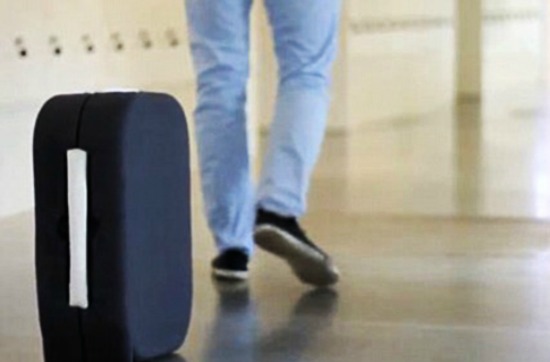The Best Inventions of 2012 You Haven’t Heard of Yet (Part 2)
Here’s the second half of a list of innovations that, while not as splashy as Google Glass, may actually become a bigger part of our daily lives.
![]()

Finally, a suitcase that follows you around. Photo courtesy of Hop!
Earlier this week I rolled out the first half of a list of a dozen of the more innovative ideas of 2012.
We’re not talking Google Glass or invisibility cloaks or other flashes from the future. No, these are less splashy things, yet, in their own ways, no less inspired and probably more likely to become a part of our daily lives. They’re the creations of people joined under a common maxim, namely, “There’s gotta be a better way.”
So, muffled drum roll, please…the Fresh Ideas of 2012, Part 2:
7) While you’re at it, can you pick up a paper and some gum: Yes, suitcases with wheels were a big breakthrough, but Madrid designer Rodrigo Garcia Gonzalez says why stop there? Why should we still have lug luggage?
So he has invented a new kind of suitcase he calls Hop!. What makes it so special is that it follows you around like the most loyal of pets.
Well, technically it follows your smart phone. The suitcase contains three receivers that communicate, via Bluetooth, with an app on your smart phone and, put simply, it follows that signal. The same controller also directs a dual caterpillar track-type system on the bottom of the suitcase to move it along. If the signal gets lost, the bag locks itself and vibrates its owner’s phone.
Of course, there are issues to resolve–think of the security challenges of an airport full of roaming luggage–but Gonzalez deserves props for giving us hope that we’ll one day break loose from our bags.
8) Anticipation was so overrated: It never really made much sense: In a world increasingly geared to instant gratification, we waited for ketchup. It took forever to come out of the bottle, but we seemed willing to live with that.
Not Kripa Varanasi and his team of MIT engineers. They’ve developed a substance called LiquiGlide, which, when coating the inside surface of bottles, helps ketchup and mustard slide right out. Now this may seem a trivial modern indulgence, but, as the LiquiGlide team estimates, roughly a million tons of food could avoid being tossed in the garbage if it wasn’t getting stuck in bottles. So it’s only right that we go with the flow.
9) Which gives new meaning to “All you can eat”: While we’re on the subject of food waste, let’s give it up for WikiCells. These are the edible membranes created by Harvard professor David Edwards and French designer Francois Azambourg that encase food and liquids. In other words, it’s packaging you can eat.
The membranes, meant to mimic the skin of a grape, are made of food particles, such as cheese or dried fruit, and are held together by calcium or magnesium ions. So far, the pair have conjured up a tomato membrane containing gazpacho, an orange one filled with orange juice, a chocolate version holding hot chocolate. They’ve even created a grape-flavored pouch filled with wine. The goal is to do away with plastic bottles and packaging. Let’s raise our membranes to that.
10) Talk to the glove: Four Ukrainian students have designed gloves that can communicate with a smart phone and, as a result, developed a way for people with speech and hearing disabilities to talk to people who don’t use or understand sign language.
Their invention, which they call Enable Talk, works like this: The gloves are lined with 15 flex sensors in their fingers that can recognize sign language and transmit the message to a smart phone where it’s converted to text. The phone then says the words that the gloves sent.
11) So now we can stay focused on not changing the oil: If you’re like me, you have no idea when you last checked your tire pressure. It’s a blind faith thing. As long as the tires keep rolling, no need to look for that little gauge you bought many tires ago.
Goodyear understands this so they’ve gone ahead and invented a tire that takes us out the equation. It does this by inflating itself. A regulator in the tire senses when the pressure drops below a pre-set point and opens to allow air flow into the pumping tube. As the tire rolls, deformation flattens the tube, pushing air into the tire cavity. And we’ll no longer have to worry about keeping our tires pumped up. Not that we ever did.
12) No longer will a charger come between you and your phone: A few years ago the 11-year-old daughter of Wake Forest University scientist David Carroll wondered aloud if a cell phone could be charged solely by human body heat. Good question, thought Carroll, and earlier this year he and his team came up with an answer.
They unveiled Power Felt, a fabric that uses nanotechnology to convert heat into electricity. It’s still in the early stages of development but initial results suggest they’re on to something big–an inexpensive material that could use the heat from your car’s engine to run its AC and radio and the sun to power your home’s appliances and yes, your own personal warmth to keep your cell phone alive. Thanks, Dad.
Video bonus: While we’re talking about nifty ideas whose time is about to come, it’s pretty certain that Samsung will come out with a bendable phone next year. As you can see in this video, it passes the hammer test.
More on Smithsonian.com
/https://tf-cmsv2-smithsonianmag-media.s3.amazonaws.com/accounts/headshot/randy-rieland-240.png)
/https://tf-cmsv2-smithsonianmag-media.s3.amazonaws.com/accounts/headshot/randy-rieland-240.png)